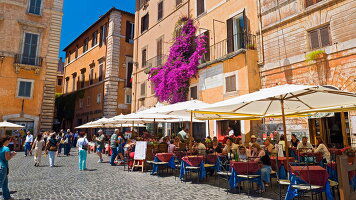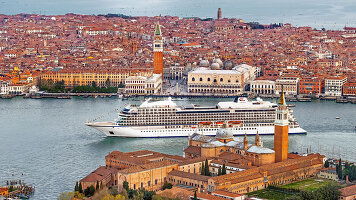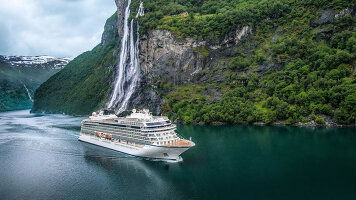Overview
Itinerary
Lisbon has inspired explorers for centuries with its stunning setting at the Tagus River's mouth. Its labyrinthine streets carry echoes of 16th-century navigators who sailed on the winds of the Age of Discovery. The city prospered greatly from its trade. And today's streets are lined with the legacies of wealthy builders, including the Jerónimos Monastery and Belém Tower, stunning works that introduced Manueline architecture. Savoring local cuisine and port wine are favorite pastimes here. On any evening, the strains of fado spill from clubs in the historic Alfama District.
Throughout Lisbon, fascinating monuments tell this proud city's story. Along the riverfront, in Praça do Comércio, an equestrian statue at its center represents Portugal's King José I, who capably rebuilt the city following the devastating 1755 earthquake. Among the most recognized of Lisbon's monuments is the grand Monument to the Discoveries on the banks of the Tagus River, displaying statues of more than 30 contributors to exploration, whose bravery and spirit still shape the culture of this vibrant European capital.
Cádiz lies on Spain's breathtaking province of Andalusia and gained incredible wealth during the 18th century; riches from the Americas were unloaded here after the Guadalquivir River to Seville silted up. This scenic southern region is home the matador and world-class equestrian art. Seville, city of polyamorous suitor Don Juan, boasts plenty of its own glories. Its grand cathedral, Alcázar Palace and Tower of Gold were built from the coffers of Spanish kings, but its fiery flamenco defines its true spirit. It is best to ponder it all while sipping sherry at a bodega.
A pivotal port city linking Africa and Europe, Tangier lies just nineteen miles across the Strait of Gibraltar from the Iberian Peninsula. Long coveted for its strategic location where the Atlantic and Mediterranean meet, numerous empires called it their own throughout history. The city's vibrancy and multicultural air attracted all manner of artists in the late 20th century, including Henri Matisse and Paul Bowles. Tangier's ancient, walled medina brims with the pleasures of Morocco, from intricate carpets and finely made slippers to fresh dates.
Granada is a splendid canvas of Moorish architecture, rich Andalusian tradition and remarkable history. It was the last stronghold of the Moorish Nasrid dynasty, whose 250-year reign ended during the 1492 reconquest of Spain by Catholic monarchs. The grand Granada Cathedral is a soaring celebration of that victory; its Royal Chapel holds the tombs of Queen Isabel and King Ferdinand, the celebrated pair who oversaw the triumph. Their magnificent fortress-palace, the Alhambra, was long the stronghold of Moors, and so offers a magnificent blend of Islamic and Christian detail.
The charms of Murcia lie in its embrace of its rural pleasures. Surrounded by farmland and fertile huertas , Murcianos are never at a loss for produce freshly plucked from “Europe's orchard.” They, in turn, live by the patient cycle of the harvest, going about their days at a leisurely pace. The Moors founded the city in 825 and introduced a vast irrigation network for crops and for city use. They were expelled by Ferdinand III of Castile in 1243. Murcia province remained a vassal kingdom until 1812 and became an autonomous region of Spain in 1982.
Visitors flock to this spectacular haven for sun, relaxation and Mediterranean breezes. Remnants of past civilizations abound: the massive La Seu Cathedral in Palma was built over a mosque, and the Almudaina Palace was originally constructed as an Arabian fort. The picturesque village of Valldemossa invites long strolls and samplings of the island's jellied breadsticks. Here, at the foot of forested mountains, a Carthusian monastery housed devout monks for 436 years. Composer Frédéric Chopin spent the winter of 1838 writing some of his best work in this tranquil setting.
The vibrant city of Barcelona, with its lively culture and inviting outdoor spaces, preserves a rich history. Picturesque medieval lanes wind through the oldest part of the city, the Gothic Quarter, where remnants of the city's Roman wall were uncovered. Its treasures include the neo-Gothic Barcelona Cathedral, the medieval Jewish district of El Call and the Romanesque Church of Santa Maria del Pi. In the evenings, diners relax in the Royal Plaza at restaurants along the elegant square's perimeter.
Barcelona is steeped in history, with stunning architecture and a rich culture. Mediterranean breezes grace the shore and Catalonia's capital is a feast for the senses. Long strolls on wide boulevards—such as Las Ramblas, the mile-long leafy pedestrian way, and the Passeig de Gràcia, lined with some of Europe's most elegant buildings—set the tone for a city that moves to its own tempo. Native son and famed architect Antoni Gaudí adorned his city with whimsy, whether along fantastical city blocks or with his colossal masterpiece, the towering La Sagrada Família cathedral.
In a picturesque setting on France's southern coast, Sète is renowned for its vibrant atmosphere and cultural charm. Known as the “Venice of Languedoc,” its network of canals offer an alluring ambience, with boats bobbing in the water and colorful buildings lining the banks. Due to its booming fishing industry, Sète features an array of delicious seafood, centered around the town's bustling fish market, Les Halles de Sète. The best way to explore is on foot or by bicycle, where you can while away the time along the canals that link the Mediterranean to the Thau Lagoon.
Marseille is rich in historic treasures, nestled between the Mediterranean and rocky hills of limestone. Two 17th-century fortresses dominate the charming Vieux Port, or Old Port, the natural harbor that hosts all manner of watercraft, from sleek elegant yachts to old style fishing vessels. Its picturesque quay is one of the world's most romantic walks, lined with dozens of cafés and shops. Also worth exploring is the city center, graced by La Canebière boulevard. Linger in a café and sample the city's signature bouillabaisse made from freshly caught fish.
The chic city of Monte Carlo in the petite kingdom of Monaco boasts some of the world's most exclusive shopping and a beautiful old port. A fairy-tale aura has settled on this glittering city of the Grimaldi family, perhaps nowhere more elegantly than at the Prince's Palace, where the late American actress-turned-princess Grace Kelly presided with Prince Rainier III. Monte Carlo's medieval quarter perches on “The Rock,” an escarpment at the foot of the Maritime Alps, and offers spectacular views of the Mediterranean and the harbor lined with mega-yachts.
Tuscany is known equally as the cradle of the Renaissance and a center of culinary delights and astounding wines. Throughout this emerald-green countryside dotted with cypress trees, endless delights unfold. Among them is Florence, a living museum of the Renaissance. Brunelleschi's famous Duomo dominates the medieval cityscape—an architectural achievement. Another Tuscan treasure, the Square of Miracles, unfolds in Pisa. Here, a trinity of masterpieces—the Leaning Tower, Pisa Cathedral and Baptistery—comprise some of Europe's finest art and architecture.
Tuscany is known for its scenic beauty and exudes a unique, rustic character. Vineyards, olive tree groves, wheat fields and endless expanses of farmland skirt the bases of medieval hill towns as they march across an undulating landscape of gentle hills. Fertile soils produce some of the world's finest wines, including Chianti and Vino Nobile di Montepulciano. More than this, many consider Tuscany the birthplace of the original farm-to-table movement. Simple, honest food graces the Tuscan table, from creamy cheeses to thick Florentine steak grilled over a wood fire.
For centuries, Rome ruled much of Europe, building a vast empire from the power of emperors. More than 2,500 years of history live in the city's streets. Ancient structures recall those heady days when the cheers of 80,000 spectators roared from the Colosseum, citizens mingled in the Forum and senators asked the gods for guidance at the Pantheon. Along with the Vatican and St. Peter's Basilica, this rich pocket of Italy is one of the world's greatest repositories of history and civilization.
Naples boasts a long history in a stunning seaside setting and has long been a major center of Italian culture. The city was the seat of a powerful independent kingdom for 500 years. So great was its sway that it lured the region's finest architects and artists. In the grand Piazza del Plebiscito, the grand and sweeping public square, the San Francesco di Paola Church flaunts a colonnaded facade reminiscent of the Pantheon in Rome, and the Royal Palace overlooks Neapolitans with statues of all the kings of Naples peering out from alcoves.
Sicily has been shaped by countless civilizations, from Greek to Byzantine to Roman. When it fell under Spain's purview in the 17th century, it was celebrated as one of Europe's ten great cities. Surrounded by undulating mountains, orange and olive groves and vineyards are plentiful. During World War II, Messina was the destination of the unofficial “Race to Messina” between US General Patton and British Field Marshall Montgomery. In the end, Patton arrived just hours before his British comrade, receiving credit for securing Sicily.
Sail the gateway to the Adriatic, marked by the sole of Italy's boot and the western coasts of Albania and Greece.
Souda Bay enjoys a picturesque setting between Crete's Akrotiri Peninsula and Cape Drapano. Historic fortifications, vestiges from the island's days under the Venetian Empire, greet ships at the mouth of the long bay, one of the deepest natural harbors in the Mediterranean. Crete is said to have been home to Europe's earliest civilization—the Minoan civilization. The legendary Palace of Knossos was the royal residence at its center; its ruins were first discovered during the late 19th century and excavation took more than 35 years.
One of antiquity's best-preserved cities, Ephesus offers an unparalleled look into the lives of the ancients. Many of its ruins have endured from the time Ephesus was one of the largest metropolises of the ancient world. Excavations reach back to the 10th century BC, when this city hosted one of the Seven Wonders of the Ancient World—the Temple of Artemis. Today, Ephesus is still full of wonders: the towering facade of the Library of Celsus, the massive amphitheater that once sat 25,000 spectators and residences adorned with frescoes.
Athens has been called the “birthplace of democracy.” Its legacy looms large from atop Acropolis Hill, the pinnacle of ancient Greece. This open air museum is an astonishing repository of once-mighty structures. From its colonnaded Parthenon—more than 2,600 years ago—revered Greek philosophers like Plato and Aristotle formulated new ideas of government and debated its role in civic life to captivated audiences. Remnants of spiritual life are also here in the several temples to Athena and Zeus.
For a more intimate experience of Athens, the charming Plaka District invites guests with its labyrinth of cobblestone lanes. Neoclassical architecture lines the narrow streets of the “Neighborhood of the Gods,” so named for its location. Browsing its shops or simply perusing its nooks and crannies are pastimes favored by visitors and locals alike. This historic area is the ideal setting in which to enjoy traditional small plates of mezes and a sip of ouzo.
The capital of Greece, Athens is one of the world's oldest cities. Continuously inhabited since at least 3,000 BC, the city has experienced many different periods of independence and occupation, including rule by the Romans, Crusaders and the Ottoman Empire. Following the Greek War of Independence, Athens was made capital of the new state of Greece in 1834. Today, ancient monuments from the city's time as the cradle of early Western civilization still stand, protected amid the frenetic pace of modern life in this cosmopolitan metropolis.
Crete was home to the Minoans, Europe's earliest recorded civilization. Its capital, Heraklion, grew from the riches of the Venetian Empire, which ruled here for four centuries. Crete enjoyed a Renaissance building boom that helped bolster Heraklion as the region's most strongly fortified city. The island is blessed with generous beaches, soaring mountains and coursing rivers. It is also where the distinct mantinades —couplets of love accompanied by Cretan instruments—could break out at any number of cafés where patrons sip tsikoudia , a grape-based brandy distilled in the hills.
Rhodes is home to the Palace of the Grand Masters, a remarkable and sprawling fortification. Its historic quarter is Europe's largest active medieval town. Outside the city, forests of pine and cypress blanket mountain slopes; vineyards and groves of citrus and olive soak up the Aegean sun. The Knights of Saint John of Jerusalem conquered the island in the 14th century, bringing great wealth from the Holy Land. Under their rule, the city was reconstructed to mirror the medieval ideal. Many of the buildings from this era remain and make for rewarding strolls.
The ancient city of Ephesus was once one of the busiest ports in the Mediterranean, and a leading trading hub filled with travelers and merchants. Quality goods, such as wine and spices, would have entered the city along the stately Harbor Street, a colonnaded road that displayed the wealth of Ephesus. Temples and public baths lined the path and led to the stately Great Theatre. Ephesus's fortunes eventually dried up with its harbor, when it was silted in by a nearby river, but its grand Harbor Street can still be walked along today, where echoes of its past can be admired.
Çanakkale was an object of desire dating back to the ancient Greeks. Today, the nearby ruins of Troy, once a powerhouse of Asia Minor, provide a glimpse of the region's former glory. The remarkably preserved structures of this UNESCO World Heritage Site offer hints of life here in the days of Alexander the Great and the later Roman Emperor Augustus. But it is the fabled Trojan Horse that is most prominent here. In Homer's Iliad , the wooden steed gave ancient Greeks entry to the city during the Trojan War, and its legend is still very much alive today.
Istanbul exudes a fascinating mix of Western and Eastern cultures. Its strategic locale led to its role as a significant center of trade—eventually becoming a cultural crossroads along the world-famous Silk Road. One of the city's stunning centerpieces is Hagia Sophia, founded as a basilica, converted to a mosque, then a museum; it is now a mosque again and features exquisite mosaics and frescoes. The city's Grand Bazaar offers a rich taste of Turkish culture, from a vast selection of carpets and fabric to luscious dates and the local sweet favorite, Turkish Delight.
Bid farewell to your fellow guests and journey home. Or spend more time exploring, perhaps joining one of our extensions.

Trip Reviews (1) Most Recent 'Iberia, the Mediterranean & Aegean' Reviews
Brochure

Viking River, Ocean & Expedition Voyages (2025-27)
Dates & Pricing
 USD
USD
Viking Cruise $25 Deposits!
Cabin Layout Options:
Select Cabin Preference:
Tour & cruises prices are per person. Prices shown have savings applied, are subject to availability and may be withdrawn at any time without notice. Pricing and trip details are correct at this point in time, however are subject to confirmation at the time of booking and are subject to change by Viking. For cruise itineraries, cabin images are sourced from the cruise-line and should be treated as indicative only. Cabin inclusions, upholsteries and room layout may differ to the image(s) shown depending on the ship selected and your sailing dates.









